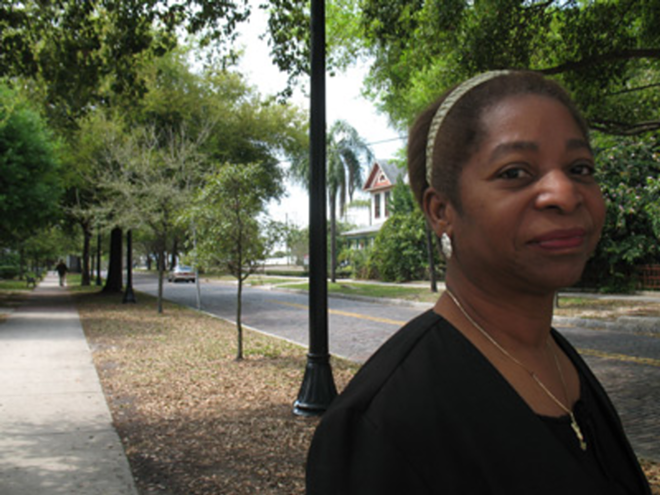
Who? Lena Young-Green, longtime Tampa Heights community activist.
Sphere of influence: Immediately after moving to Tampa in 1984, Young-Green joined the Tampa Heights Civic Association. Through three mayoral administrations, the Belize native has organized neighbors and pressured city officials for safer streets, more civic participation and redevelopment of Tampa's oldest neighborhood. From 1984 to 2000, Young-Green worked as senior legislative assistant to former State Senator James T. Hargrett, where she networked with Hillsborough county officials, planning commission members and various state agencies. She currently serves on Tampa's Enterprise Zone Development Agency, and also acts as director of governmental affairs for the Institute for Research, Evaluation and Policy Analysis (IREPA), a consulting firm that advises government, education and nonprofit agencies on public policy and grant writing. Her latest project is the Tampa Heights Junior Civic Association, which she founded in 1998.
How she makes a difference: By combining government experience with grassroots organizing, Young-Green has been instrumental in revitalizing Tampa Heights. For 24 years, she's pushed for responsible redevelopment, culminating in a neighborhood plan that sets high standards for any building project in the neighborhood — the first in Tampa. That plan led to the ambitious project "The Heights," a $500-million urban village of residences, shops and restaurants along the Hillsborough River.
CL: Your past work shows you have the ability to impact policy. Why get so heavily involved in a small neighborhood like Tampa Heights?
Young-Green: I enjoy community work. I really do. I really believe that community folks many times aren't aware of how much they can impact policy that then turns around and benefits the larger community. But that's what I've seen. If we understood how much we could be involved in the policy process, then some of the cycles that we see all the time — that our communities don't seem to be moving forward — would be broken. The more we learn from the grassroots level, the better we'll learn how to make things happen on a larger scale, which impacts where we live.
How did The Heights project begin?
[Young-Green explains at length earlier development ideas of former mayors Sandy Freedman and Dick Greco that didn't mesh with the neighborhood.] When current Mayor [Pam] Iorio came in, we heard that there were new developers looking at the [Hillsborough] River. And she did such a tremendous thing: She said to them, to Bill Bishop [of A Better Place Inc.], that the plan looked really nice and probably would be doable, but they shouldn't come back to talk to her until after the neighborhood was on board. If there's anything to me that demonstrates the importance of being involved at the policy level, I think that is one of the key things. That immediately set a trend where Bill Bishop and his group identified who were community leaders, or community-involved, and called a meeting. The conversation started from there. That was a real moment for me. We became part of the process. And becoming part of the process meant that we were empowered.
What is the status of The Heights project?
As you know, the housing market has changed significantly. So now, of course, we're in a slump with housing and the first part of the project was going to be the housing component. Darren Booth [one of the developers] did a presentation to our civic association last month and they are looking to get something stimulated for commercial [development]. The commercial was going to be the last part. ... They are working on moving some of the commercial investments earlier, and they are looking for a longer period of time with the residential. ... But I really believe that eventually this is going to be a good project.
Why did you start the Tampa Heights Junior Civic Association?
As we looked around the community, our [Tampa Heights Civic Association] board, along with myself, agreed we needed to address our kids. We were getting older, we're civic-minded and we thought our kids were civic-involved. But we have all these kids out there that haven't felt they are stakeholders .... So the board voted to approve the creation of the Junior Civic Association. ... As the kids came, we realized that we couldn't be telling them about civic leadership when they weren't even achieving in school. Now... we spend time helping kids get the academics.
There was a lot of strife between Tampa Heights residents as the neighborhood began to gentrify. How were you able to bring the wealthier newcomers and folks from the public housing together?
I think it's really just our commitment to making people work together instead of excluding them. When I first moved into Tampa Heights, we had a high percentage of renters. But our community was having problems; it just wasn't working with the ratio that we had. And I certainly was not going to be the one to say that any group needs to move. But we needed reinvestment in the area. So how do we figure out how to balance this thing? How do you bring all these parts together? I think sometimes, as we raise the kids and work with the kids, it's simply a lack of exposure. What you are exposed to here is not what they're exposed to over there. So how could I expect you to sit at the table and come together naturally if your outlooks are so completely different? You got to get people to sit around and talk. That's what drives us to be as inclusive as we can, even when it seems impossible.

